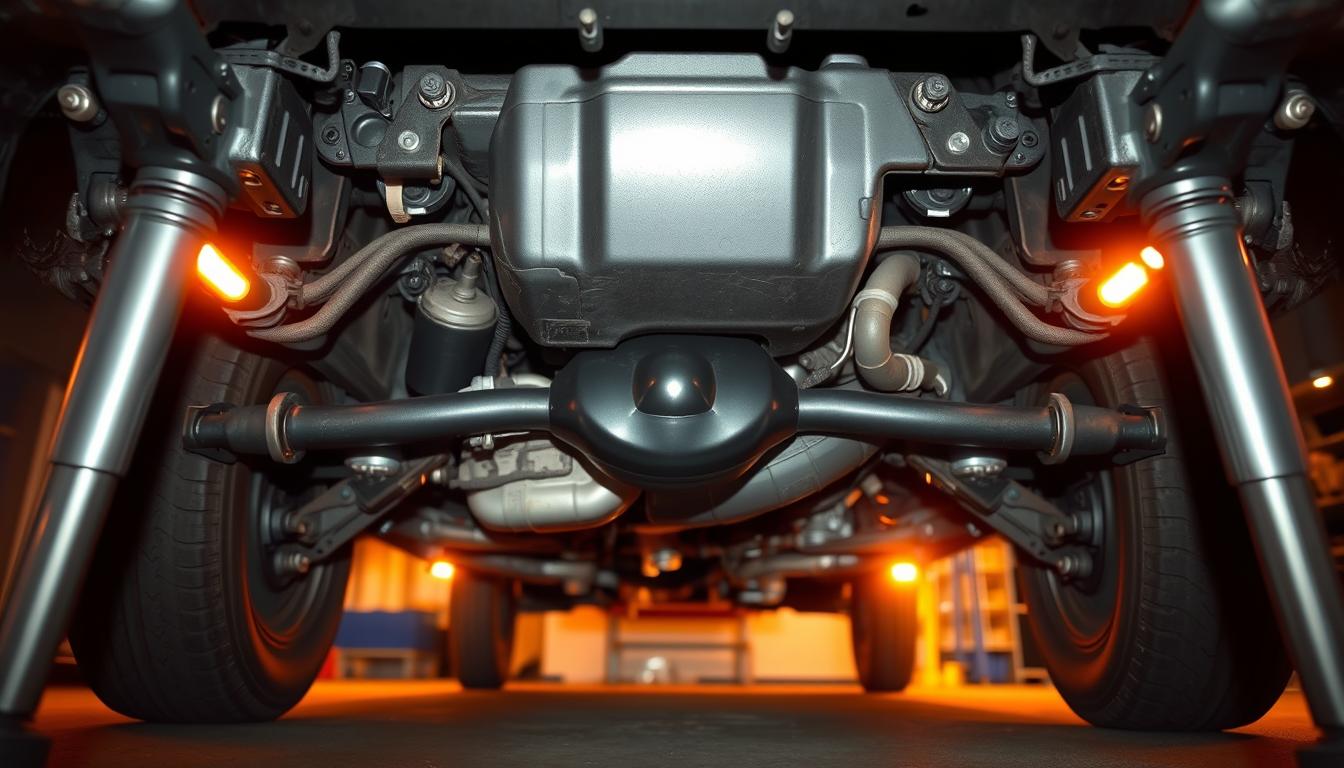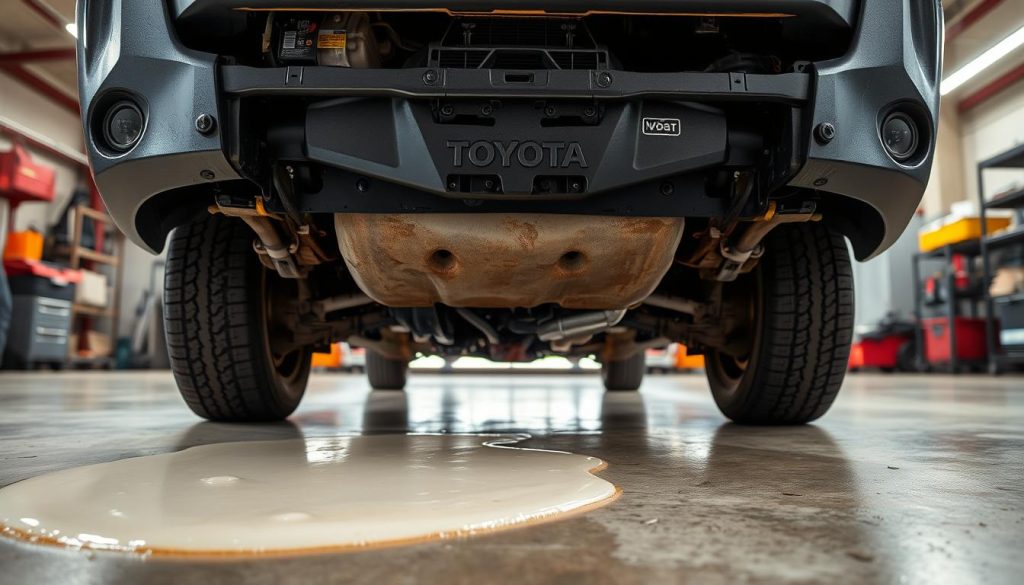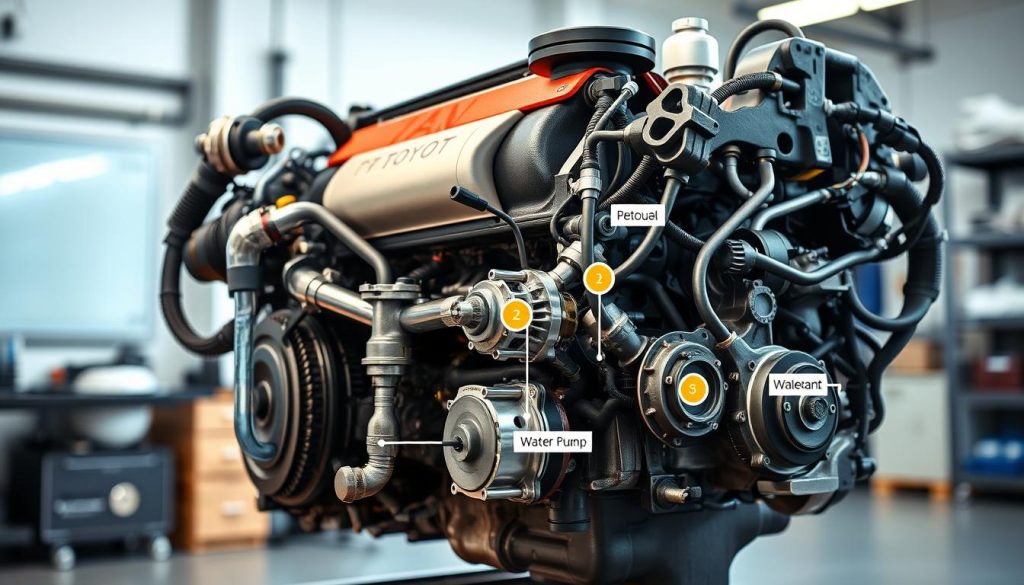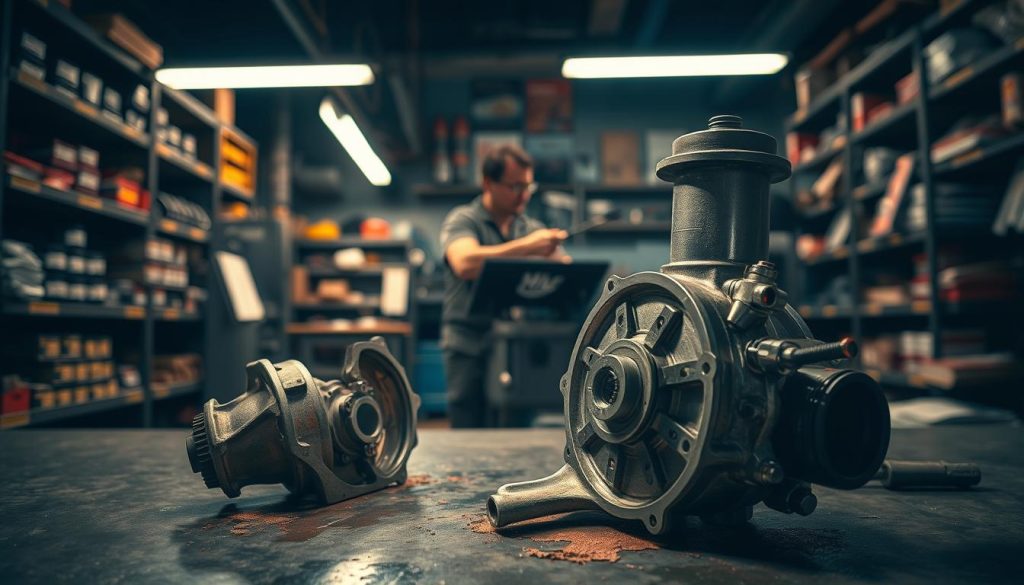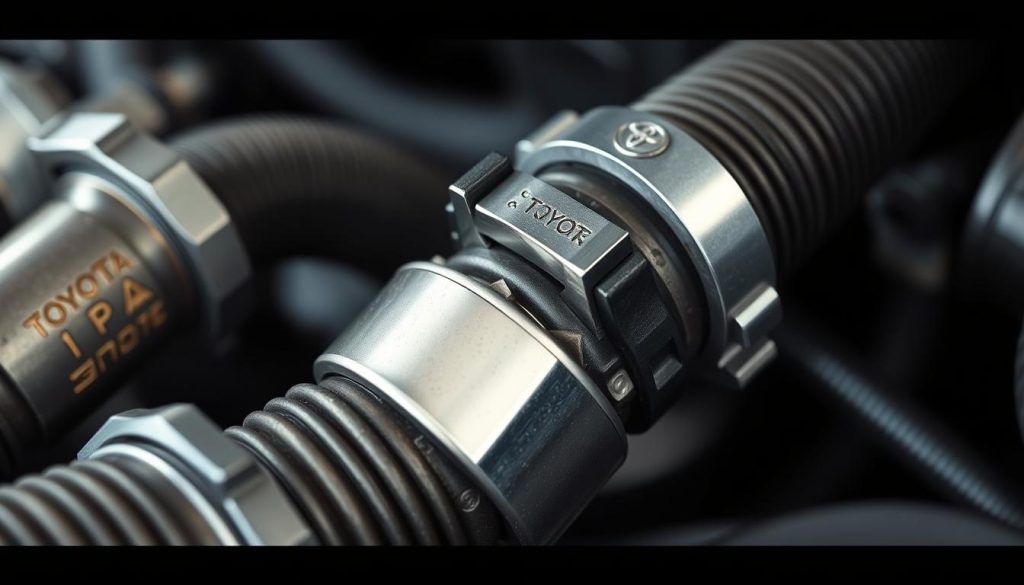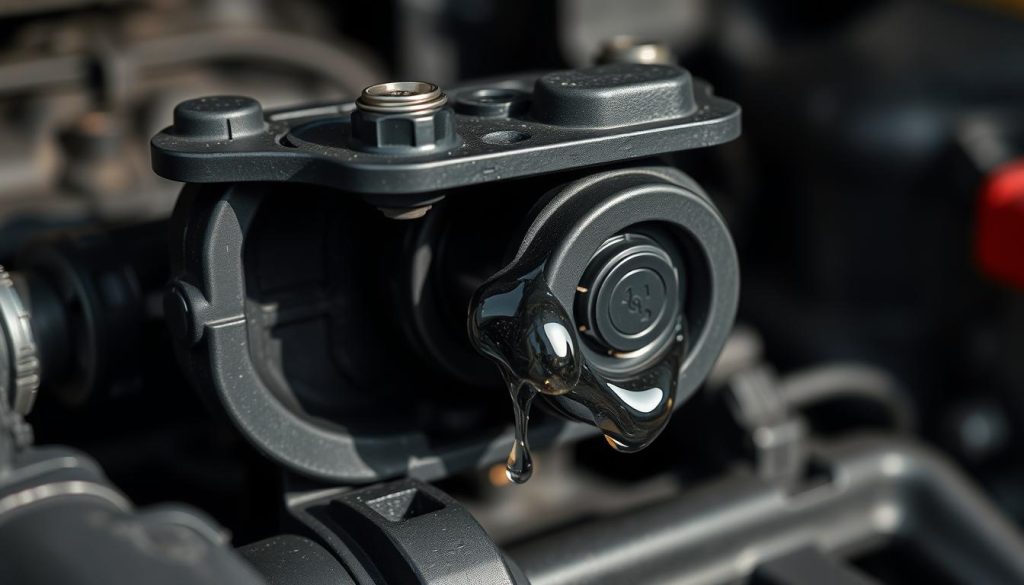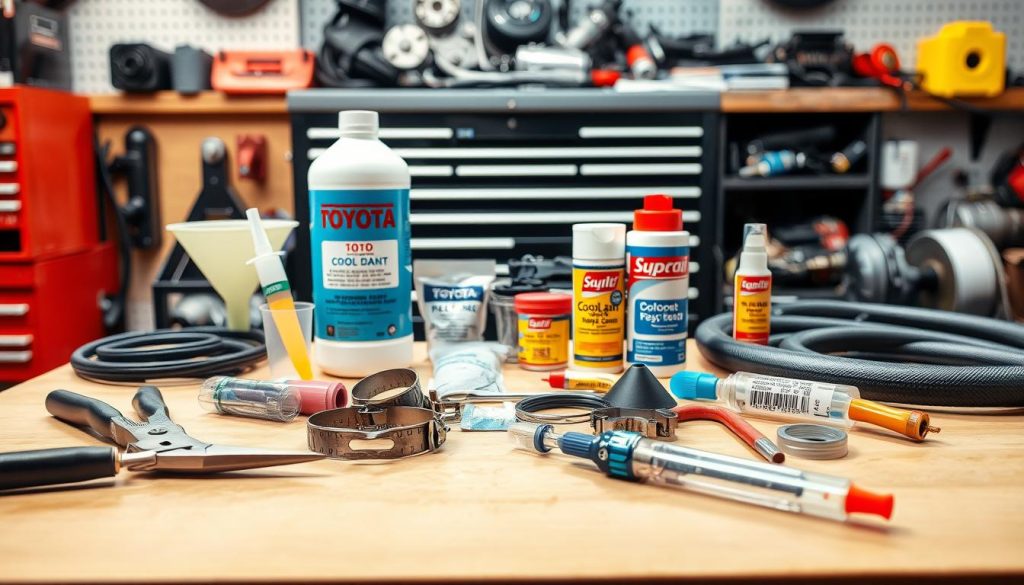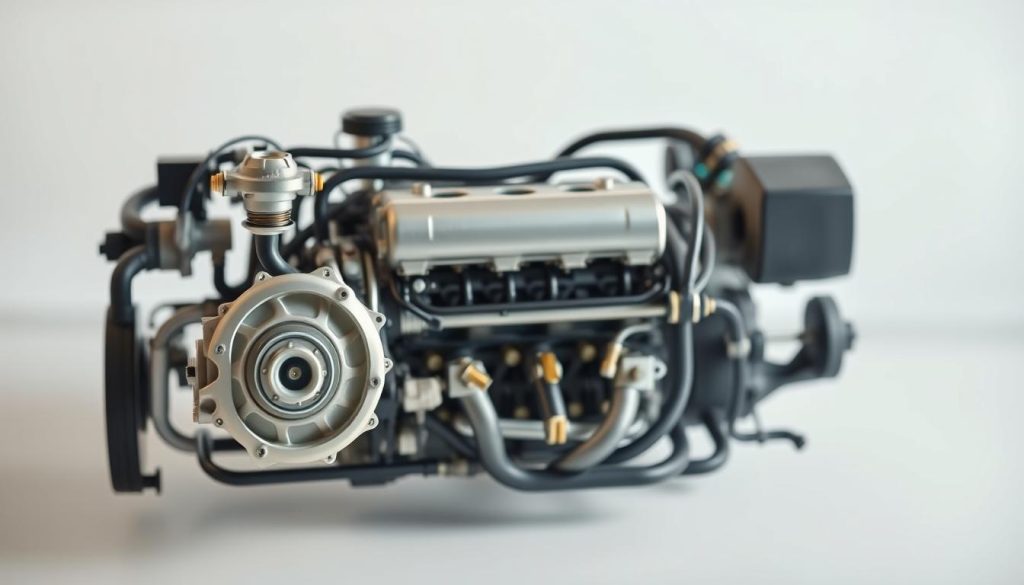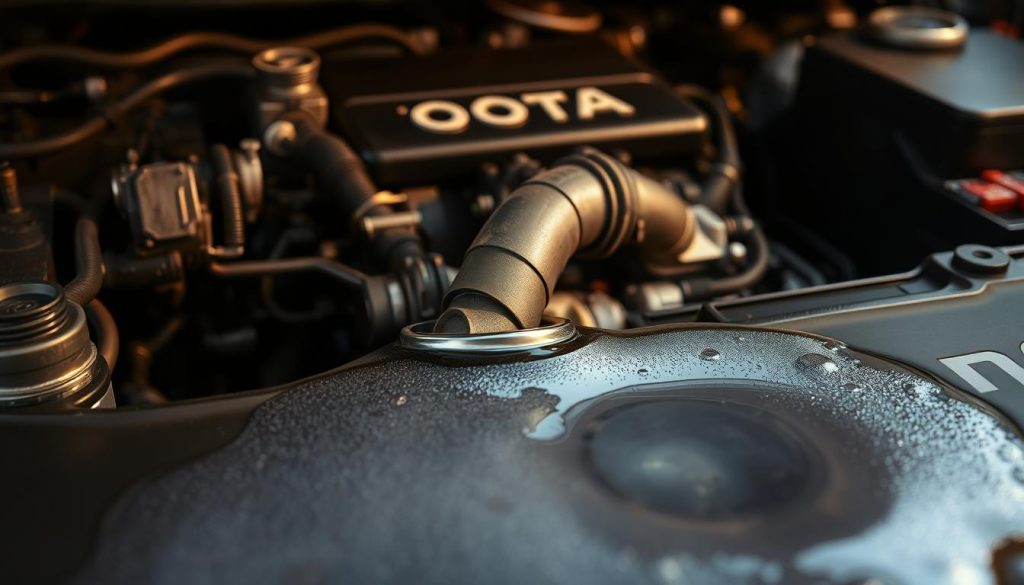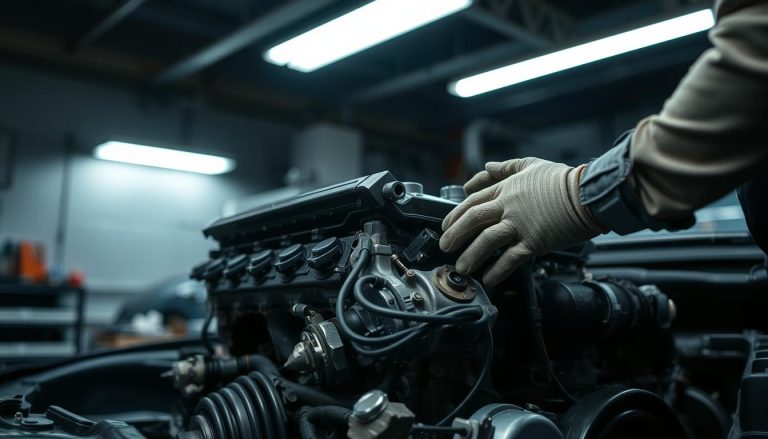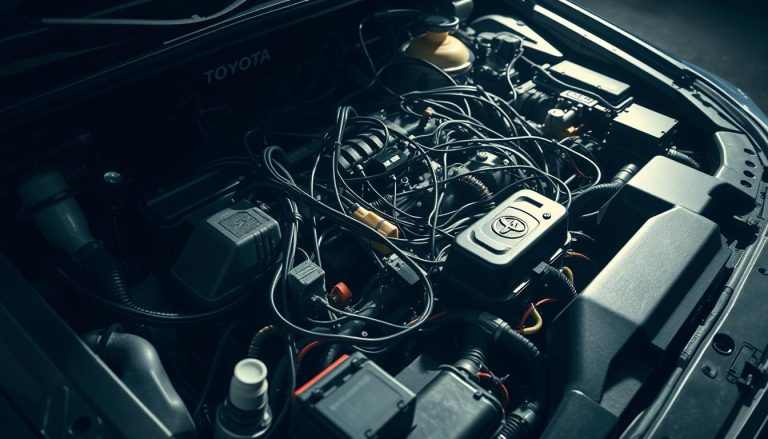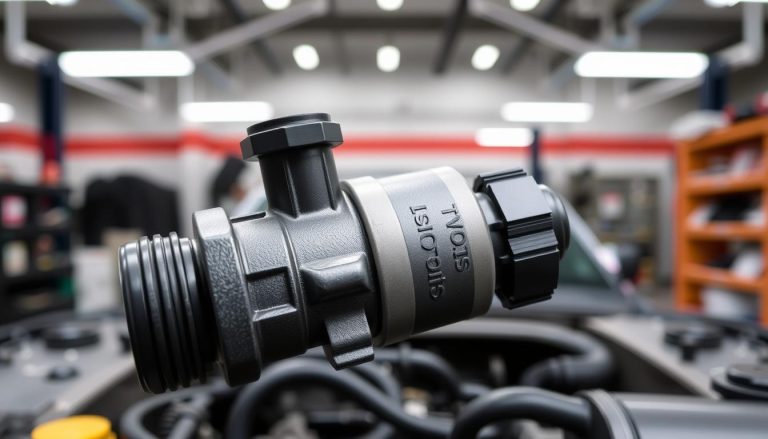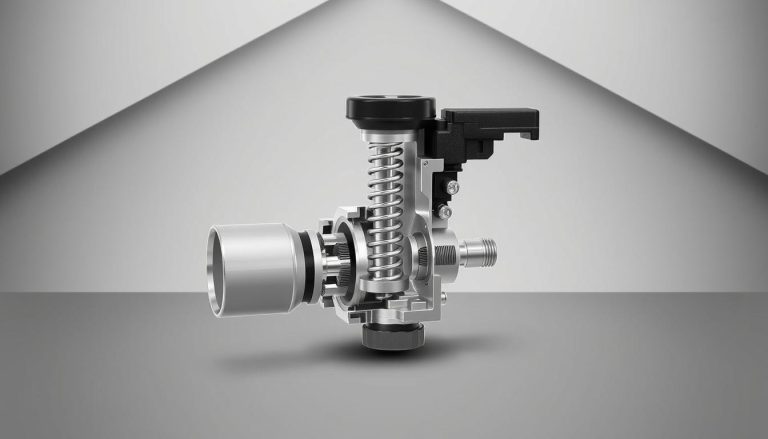Toyota Coolant Leak: Symptoms, Causes, and Solutions
Your car’s cooling system keeps your engine running smoothly. If you see fluid dripping under your car, it’s a sign to act fast. Engine overheating can lead to thousands of dollars in damage if ignored.
Many drivers notice puddles under their cars but don’t know what to do. Sweet smells from the engine and rising temperature gauges are clear warnings. These problems don’t solve themselves and can get worse over time.
This guide helps you spot coolant leak symptoms before they turn into costly issues. We’ll cover common causes and solutions. Whether it’s a loose hose or radiator trouble, you’ll know when to fix it yourself or call a pro.
Understanding your Toyota’s cooling system saves money and prevents emergencies. Let’s dive into how to keep your engine cool and your wallet happy.
Key Takeaways
- Sweet smells and puddles under your car signal cooling system problems
- Rising temperature gauges need immediate attention to avoid engine damage
- Regular fluid checks catch issues before they cost a lot to fix
- Loose hoses and worn radiators are common causes of cooling system failures
- Early detection and quick repair prevent expensive engine replacement costs
- Professional diagnosis is best for complex cooling system issues
Understanding Your Toyota’s Cooling System
Learning about your Toyota cooling system can save you a lot of money. It keeps your engine cool, preventing damage. This is key to avoiding costly repairs and breakdowns.
Your cooling system has many important parts. Each one does a specific job to keep your engine at the right temperature.
- Radiator – Dissipates heat from the coolant
- Water pump – Powers coolant circulation throughout the engine
- Thermostat – Regulates coolant flow based on temperature
- Hoses – Transport coolant between components
- Coolant reservoir – Stores excess fluid and maintains proper levels
The radiator function is all about heat exchange. Hot coolant goes through thin tubes. At the same time, air cools the fins. This cools the fluid before it goes back to the engine.
Your water pump keeps the coolant moving. It uses a belt to drive the impeller. This keeps the engine from overheating and prevents damage.
The thermostat controls the coolant flow. It closes when the engine is cold to help it warm up faster. Once it’s warm, it opens to let the coolant flow freely.
Knowing how your cooling system works helps you spot problems early. It also lets you talk better with mechanics. This way, you can make smarter choices about your car’s care.
Keeping an eye on your Toyota cooling system can stop small issues from becoming big ones. Just a quick look can show you if something’s wrong before it’s too late.
Recognizing Toyota Coolant Leak Symptoms
Coolant leaks often start slowly, so catching them early is key. Spotting these signs early can save you a lot of money and keep your Toyota running well. Your cooling system will show you signs of trouble, so it’s important to know what to look for.
Visual Signs of Coolant Leaks
The most obvious signs are the ones you can see. Coolant puddles under your car are a clear warning. These puddles are bright green, orange, or red and easy to spot.
Look for colorful stains or wet spots where you park. Fresh coolant puddles feel sticky and smell sweet. You might also see low coolant levels in your reservoir tank, near the radiator under the hood.
Performance-Related Symptoms
Your Toyota’s performance will change with coolant leaks. Engines running hotter than usual are a big warning sign. You might see your temperature gauge climb during driving or overheating often.
A sweet, syrup-like smell is another sign. This smell can be inside your car or around the engine. The smell gets stronger when your engine is warm and means coolant is leaking.
Warning Signs on Your Dashboard
Modern Toyotas have systems that alert you to cooling issues. Engine temperature warning lights are your first defense against damage. These warnings look like a thermometer icon or gauge on your dashboard.
Watch for your temperature gauge going into the red or warning lights flashing. Some Toyotas also show low coolant level warnings on the dashboard. Never ignore these engine temperature warning signals – they’re there to protect your engine.
How to Inspect Your Toyota for Coolant Leaks
Finding coolant leaks early can save you money and protect your Toyota’s engine. You don’t need to be a pro to do a coolant leak diagnosis. With simple tools and steps, you can spot most cooling system issues before they get expensive.
Regular cooling system inspection keeps your Toyota running well and avoids sudden breakdowns. It involves looking closely and using special tests to find hidden leaks.
Safety Precautions Before Inspection
Never check your cooling system when it’s hot. Wait 30 minutes after driving to start. Hot coolant can burn you badly and cause system pressure issues.
Wear safety glasses and gloves to protect your skin and eyes from coolant chemicals. Use a flashlight to see dark spots under the hood.
Make sure your Toyota is parked on level ground with the parking brake on. This helps get accurate fluid levels and keeps the car from moving during inspection.
Step-by-Step Visual Inspection Process
Begin by looking at the radiator front. Search for green, orange, or pink stains on the fins and brackets. These colors show where coolant has leaked before.
Next, check all hoses for cracks, swelling, or soft spots. Pay extra attention to where hoses connect to other parts. These spots often leak first.
Then, look at the water pump area, behind the cooling fan. Check for coolant stains or white deposits around the pump. A failing water pump might show small leaks early.
Lastly, check the ground under your Toyota. Fresh coolant puddles mean active leaks. Old stains show intermittent problems that need fixing.
Using Tools for Leak Detection
Pressure testing is the best way to find hidden leaks. A cooling system pressure tester connects to your radiator and pressurizes it. This shows where the system is weak.
Apply 15 PSI of pressure and watch the gauge. A steady reading means no leaks. But, if the pressure drops, you’ve found a leak. This pressure testing method finds problems that only show up when the engine is running.
UV dye detection is another good method. Add fluorescent dye to your coolant, run the engine, then use a UV light to find leaks. The dye glows under UV light, making small leaks easy to see in dark areas.
Common Causes of Toyota Coolant Leak Issues
Many things can cause coolant leaks in Toyotas, from wear and tear to environmental damage. Knowing what causes these leaks helps you fix problems early. Most leaks come from parts that wear out over time.
Age-Related Component Wear
Parts in the cooling system wear out with age. Rubber hoses get brittle and crack. Component wear also affects seals in the water pump, leading to slow drips.
Metal parts like radiators corrode from chemicals and road salt. Clamps lose their grip, causing leaks. Even plastic parts can crack from heat and cold.
Temperature-Related Damage
Extreme temperatures can quickly damage the cooling system. Overheating warps metal and destroys seals. Temperature damage from freezing can crack engine blocks and radiators.
Summer heat expands coolant, stressing hoses. Winter cold makes rubber parts stiff and prone to splitting. These temperature changes speed up wear.
Manufacturing Defects and Recalls
Some Toyotas have cooling system problems covered by recalls. Faulty radiator designs affected some Camry models. Water pump issues plagued certain engines across models.
Manufacturing defects often appear early in a vehicle’s life. They usually affect the same parts in similar vehicles. Checking for recalls can save you money on repairs.
| Cause Category | Common Components | Typical Timeline | Prevention Method |
|---|---|---|---|
| Age-Related Wear | Hoses, Clamps, Seals | 5-10 Years | Regular Inspections |
| Temperature Damage | Radiator, Water Pump | Immediate to 2 Years | Proper Coolant Mix |
| Manufacturing Defects | Various Components | 0-5 Years | Check Recalls |
| Corrosion Issues | Metal Components | 3-8 Years | Quality Coolant |
Radiator Problems in Toyota Vehicles
Toyota radiators face many challenges like road debris, temperature changes, and corrosive elements. They work hard to keep your engine cool but can get damaged over time. Knowing about Toyota radiator problems helps you spot issues early and avoid expensive repairs.
Your radiator is at the front of your vehicle, making it exposed to rocks, salt, and other hazards. When problems arise, you might see coolant puddles under your car or notice your temperature gauge rising.
Identifying Radiator Leaks
The most obvious sign of radiator trouble is coolant pooling directly under the front of your vehicle. This bright green, orange, or pink fluid shows your radiator is losing coolant.
You might also see your engine running hotter than usual or steam coming from under the hood. These signs often appear before you see visible leaks. Radiator leak repair is urgent when you notice these warning signs.
Regularly check your coolant reservoir. If levels drop often without visible leaks, your radiator might have small cracks that aren’t easy to spot.
Common Radiator Failure Points
The plastic end tanks are the most vulnerable part of your Toyota’s radiator. These tanks expand and contract with temperature changes, eventually developing cracks or separating from the metal core.
Corrosion attacks the radiator core itself, creating pinhole leaks that start small but grow over time. Road debris can also puncture the thin metal fins, leading to immediate coolant loss.
Connection points where hoses attach often fail due to constant pressure changes. When these areas leak, you’ll need professional radiator replacement to restore proper cooling system function.
Water Pump Failures and Leaks
The water pump is key to your Toyota’s cooling system. It circulates coolant to keep the engine cool. Without it, the engine can overheat and suffer damage.
Water pump problems can start small but grow fast. Spotting issues early is vital to keep your Toyota running well.
Signs of Water Pump Problems
Look out for signs of water pump failure. A high-pitched squeal from the engine bay is a common warning. This noise often means the pump’s bearings or impeller are failing.
A water pump leak shows up as coolant puddles under your car. The coolant is usually bright green, orange, or pink. Steam from the engine is another sign of trouble.
Fluctuations in the temperature gauge are also a warning. If your engine gets too hot or the gauge needle wobbles, the pump might not be working right.
Water Pump Location and Access
The water pump’s location varies by Toyota model. This affects how hard it is to fix and how much it costs. Most engines have the pump behind the timing belt cover, making replacement tricky.
Newer Toyotas might have the pump outside for easier service. But many models, like the Camry and Corolla, have the pump tied to the timing system. This makes repairs more complex.
| Toyota Model | Water Pump Location | Access Difficulty | Typical Labor Hours |
|---|---|---|---|
| Camry (4-cylinder) | Behind timing belt | Moderate | 4-6 hours |
| Corolla | Timing belt driven | Moderate | 3-5 hours |
| RAV4 | External mount | Easy | 2-3 hours |
| Prius | Electric assist | Complex | 5-7 hours |
Getting a pro to check your water pump leak is a good idea. Replacing the timing belt and water pump together can save money for many Toyota owners.
Hose and Clamp Related Leaks
Coolant hoses and clamps are key parts of your Toyota’s cooling system. They face constant pressure and temperature changes. Luckily, hose clamp repair and replacements are cheap fixes.
Your Toyota’s cooling system hoses link the radiator, engine, and heater core. They are made of rubber and silicone. If they fail, you’ll see signs before they break down completely.
Inspecting Coolant Hoses
Begin by checking hoses when the engine is cool. Look out for these issues:
- Cracks or splits in the rubber surface
- Soft, spongy areas that indicate internal deterioration
- Hard, brittle sections that feel stiff to the touch
- Swelling or bulging that suggests pressure damage
Focus on hose ends where they meet other parts. These spots are most stressed and often show damage first. If you see any of these signs, it’s time for coolant hose replacement.
Clamp Failure Indicators
Hose clamps keep your cooling system tight. But they can fail in different ways. Look for rust or corrosion on metal clamps, which weakens them.
Loose clamps let coolant leak out slowly, making puddles under your Toyota. Tight clamps can damage hoses, creating leaks. The right clamp should be tight but not too tight.
Thermostat Housing Leak Repairs
The thermostat housing is a key spot for leaks in Toyota’s cooling system. It holds the thermostat that controls coolant flow. Over time, the gasket wears out, leading to a thermostat housing leak that can empty your coolant reservoir.
The housing is attached to your engine block or intake manifold. When it leaks, coolant starts to seep out slowly. You might see dried coolant residue before noticing actual dripping.
Accessing the Thermostat Housing
Finding the thermostat housing varies by Toyota model. On most Camrys and Corollas, it’s near the engine’s top. But, some models need you to remove the air intake or other parts first.
Always drain the coolant before you start. The housing is connected to the upper radiator hose, making it easy to spot. Look for a round or oval metal part with bolt holes around it.
| Toyota Model | Housing Location | Access Difficulty | Required Tools |
|---|---|---|---|
| Camry (2007-2017) | Top of engine block | Easy | Basic socket set |
| Corolla (2009-2019) | Front of engine | Moderate | Socket set, pliers |
| RAV4 (2013-2018) | Behind intake manifold | Difficult | Extension bars, swivel sockets |
| Prius (2010-2015) | Lower engine area | Moderate | Low-profile tools |
Replacement Procedures
To replace the thermostat, start by removing the housing bolts in a crisscross pattern. The old gasket might stick, so you’ll need to scrape it off carefully.
Clean both surfaces well before putting on the new gasket. Use gasket sealer if your Toyota manual suggests it. Install the new thermostat with the spring facing the engine block.
Always replace the thermostat when doing housing repairs. The labor cost is the same, and thermostats are inexpensive insurance against future problems.
Proper cooling system maintenance means checking housing bolts for the right torque. Tightening too much can crack the housing, while loose bolts cause leaks. Refill the system slowly and make sure to remove all air pockets.
Head Gasket Issues in Toyota Engines
The head gasket is key in keeping your Toyota’s engine block and cylinder head separate. It stops coolant and oil from mixing. It faces high pressure and temperature changes with every drive. A failure can harm your engine and your wallet.
A head gasket leak often hides inside the engine. It lets coolant mix with oil or get into the combustion chambers. At first, the damage is slow, but it speeds up once the seal breaks.
Head gasket problems usually hit Toyotas with high mileage or those that overheated a lot. Some early 2000s Toyota models had weak head gaskets. Fixing it can cost between $1,500 and $3,000, so catching it early is key.
Identifying Head Gasket Leaks
There are signs that your Toyota’s head gasket might be failing. Milky or foam-colored oil on the dipstick means coolant is in the oil. White smoke from the exhaust when the engine is warm means coolant is burning.
Look at your radiator cap when it’s cool. Bubbles mean combustion gases are getting into the cooling system. Fast coolant loss without any leaks outside also points to a head gasket problem.
Testing for Head Gasket Problems
Experts use tests to find head gasket issues. A compression test shows if there’s pressure loss between cylinders. Chemical test kits change color when they meet exhaust fumes in the coolant.
Block testing adds dye to the cooling system that reacts to combustion gases. This head gasket repair test shows if there’s an internal leak.
Professional vs DIY Diagnosis
You can do basic checks yourself, but finding head gasket problems needs special tools and skills. DIY kits are available, but understanding them takes practice.
Getting a pro to check it costs $100-200 but can save you thousands. A skilled mechanic can tell if it’s a head gasket problem or something else. Given the cost of head gasket repair, getting a pro’s opinion is vital before big repairs.
DIY Toyota Coolant Leak Repair Solutions
Toyota owners can save a lot by fixing coolant leaks themselves. DIY coolant repair is a great way to learn about your car and save money. Most fixes need just basic tools and a weekend.
First, get the right tools and make a safe area. Having the right tools and following steps is key to success.
Essential Tools and Materials
Every Toyota maintenance job starts with the right tools. You’ll need screwdrivers, pliers, and a socket set. Also, a big drain pan to catch spills.
Get fresh coolant that fits your Toyota’s needs. Most need a 50/50 mix of antifreeze and water. Also, get new hoses, clamps, and gaskets if needed.
Wear gloves, safety glasses, and old clothes to stay safe. Gloves protect from coolant chemicals, glasses shield your eyes, and clothes prevent stains.
Step-by-Step Hose Replacement
Coolant hose replacement starts with a cool engine. Never do this on a warm engine to avoid burns. Wait two hours after driving.
Find the broken hose and put a drain pan under it. Loosen the clamps with a screwdriver, turning counterclockwise.
Take out the old hose by twisting and pulling. Clean the area with a rag to remove old coolant. Put the new hose on by pushing it onto both ends.
Clamp Tightening Procedures
Proper clamp installation stops leaks and keeps the system working. Place clamps about an inch from each end, avoiding the tip.
Tighten the clamps slowly with a screwdriver. Press firmly but don’t overdo it. The clamp should fit snugly without harming the hose.
Safety Considerations
Be careful with car fluids. Never pour old coolant down drains or on the ground. Auto parts stores and service centers recycle used coolant.
Check your fix by running the engine and looking for leaks. Watch the temperature gauge closely during the first drives.
When to Seek Professional Help
While you can fix some coolant problems at home, others need a pro. Knowing when to call for professional coolant repair can prevent costly errors. It ensures your Toyota gets the correct fix the first time.
Complex Repair Scenarios
Some coolant leak repairs are more than just fixing a hose. Water pump failures need removing engine parts and timing belts. Head gasket repairs require taking the engine apart and doing precise work.
Internal engine leaks are tricky. They need special tools and lots of experience to fix right. Radiator replacement is also complex, thanks to newer Toyota models’ advanced mounting systems.
Engine block, cylinder head, or transmission cooler line leaks need a pro. These repairs need special knowledge and follow factory procedures.
Cost-Benefit Analysis
Think about the whole picture when deciding between DIY and Toyota repair costs. Professional repairs offer warranties, proper diagnosis, and guaranteed results.
Consider these points:
- Cost of specialized tools you’ll only use once
- Risk of causing more damage during repair
- Time needed for complex repairs
- Warranty coverage on professional work
Professional service might be cheaper than buying tools and parts after a DIY fail.
Finding Qualified Toyota Technicians
Look for certified Toyota technicians with cooling system experience. Check for ASE certifications and Toyota-specific training.
Ask about their diagnostic tools and warranty policies. Good shops will explain the problem clearly and give written estimates. Reading online reviews can help find technicians known for cooling system work.
Preventing Future Coolant Leaks
Keeping up with Toyota maintenance can save you a lot of money. It’s smarter to spend a little on preventive care than a lot on repairs. Your cooling system works hard every day. Taking care of it keeps your Toyota running well for years.
Stopping small problems early can save you a lot of money. Regular checks and quality service protect your investment. By following good maintenance habits, your cooling system will run at its best.
Scheduled Inspection Intervals
Your coolant system maintenance should be on a regular schedule. Check the coolant level every month when the engine is cool. Also, look for leaks under your car every few weeks.
Toyota suggests cooling system checks every 15,000 miles. During these, technicians check hoses, clamps, and connections for wear. They also test the coolant’s concentration and pH levels to keep it working right.
“An ounce of prevention is worth a pound of cure – this couldn’t be more true for automotive cooling systems.”
Choosing the Right Coolant
Choosing the right coolant is key to a long-lasting system. Toyota specifies particular coolant formulations for their engines. The wrong type can cause damage.
Always use Toyota Long Life Coolant or similar OEM-approved products. While generic coolants might seem cheaper, they often lack important additives. These additives protect aluminum and rubber seals well.
Professional Flushing Services
Flushing the system removes debris and contaminants that can cause issues. Do this every 30,000 to 50,000 miles, depending on your driving. City driving and extreme temperatures need more frequent service.
Professional flushing gets rid of old coolant and fills the system right. It removes air pockets that can lead to overheating. Fresh coolant offers the best protection against corrosion and ensures efficient heat transfer.
Preventive care through regular maintenance keeps your Toyota reliable and valuable. Spending a little on proper service can save you a lot of money in the long run.
Toyota Model-Specific Coolant Leak Issues
Knowing about specific coolant problems in Toyota models helps owners fix issues quickly. Each Toyota vehicle has its own cooling system design. This means different failure patterns. Knowing your model’s common weak spots can save time and money.
Camry Coolant System Problems
Toyota Camry coolant systems often face the same issues across different models. Older Camry models tend to leak water pumps around 100,000 miles. The plastic radiator end tanks can crack from heat.
Fourth and fifth-generation Camrys have a weak spot in the lower radiator hose connection. The thermostat housing also leaks where it meets the engine block. Regular inspection of these areas helps avoid big coolant losses.
Corolla Common Leak Points
Toyota Corolla coolant problems often happen in the tight engine bay. The close spacing makes hoses more prone to heat damage. Models from 2009-2013 often leak from the thermostat housing.
Corolla radiators can get pinhole leaks from debris. The overflow tank connections also get brittle over time. Early detection helps avoid engine overheating in these smaller engines.
RAV4 and Highlander Issues
Toyota RAV4 cooling systems face unique challenges from their SUV design. The higher operating temperatures stress the cooling parts more than sedans. Water pump failures happen sooner in these vehicles.
Highlander models have similar issues but with more complexity from their V6 engines. The extra coolant passages mean more leak points. Both models need frequent coolant system inspections due to their demanding conditions.
Prius Hybrid Cooling Considerations
Toyota Prius coolant systems need special care because of their hybrid design. They have separate cooling circuits for the engine and hybrid parts. The inverter cooling system works on its own from the main engine coolant.
Prius models often leak in the coolant control valve area. The electric water pump can fail without warning. Professional diagnosis is key because of the system’s complexity and special parts.
Conclusion
Your Toyota’s cooling system is as important as regular oil changes and tire rotations. To prevent leaks, understand your car’s needs and watch for early signs.
By knowing the symptoms and solutions, you can protect your investment. Simple checks can spot small issues before they cost a lot. Keeping your cooling system in check helps your engine run smoothly and last longer.
Acting fast when problems show up is key to engine protection. A small leak now can cause big engine damage later. The choice between a cheap fix and a costly repair often depends on when you act.
Whether you drive a Camry, Corolla, RAV4, or Prius, the rules are the same. Use quality coolant, follow maintenance schedules, and fix issues quickly. Your local Toyota service center can offer advice for your model.
Driving with a coolant leak risks your engine with every mile. The knowledge you’ve learned helps you make informed choices about repairs. With the right care, your Toyota will last a long time.
FAQ
What are the most common signs that my Toyota has a coolant leak?
Look for colorful puddles under your car, like green, orange, or pink. Also, a sweet smell of antifreeze and an engine that runs too hot are signs. You might see low coolant warning lights on your dashboard and white steam from the engine.
Stains on your driveway or milky oil in your engine can also indicate a leak.
How much does it typically cost to fix a Toyota coolant leak?
Repair costs vary. Simple hose replacements cost -0. Radiator repairs are 0-0. Water pump replacement is 0-
FAQ
What are the most common signs that my Toyota has a coolant leak?
Look for colorful puddles under your car, like green, orange, or pink. Also, a sweet smell of antifreeze and an engine that runs too hot are signs. You might see low coolant warning lights on your dashboard and white steam from the engine.
Stains on your driveway or milky oil in your engine can also indicate a leak.
How much does it typically cost to fix a Toyota coolant leak?
Repair costs vary. Simple hose replacements cost $50-$150. Radiator repairs are $300-$800. Water pump replacement is $400-$1,200.
Head gasket repairs can cost $2,000-$4,000 or more, depending on your Toyota model.
Can I drive my Toyota with a small coolant leak?
Driving with a small leak is not recommended. Even small leaks can quickly become major problems. This can lead to engine overheating and damage.
If you must drive, keep an eye on your temperature gauge and coolant levels. Seek repairs immediately.
Which Toyota models are most prone to coolant leak problems?
Camry models, older generations, often have water pump and radiator issues. Corolla vehicles may have thermostat housing leaks. RAV4 and Highlander SUVs face cooling system challenges.
Prius hybrids have unique cooling needs due to their dual-circuit systems.
How often should I check my Toyota’s coolant level?
Check your coolant level monthly when the engine is cold. Look at the overflow reservoir. The coolant should be between the minimum and maximum marks.
During seasonal changes or before long trips, it’s important to check coolant levels and look for leaks.
What type of coolant should I use in my Toyota?
Use Toyota-approved coolant or equivalent that meets Toyota’s specifications. Most modern Toyotas use long-life coolant, which is pink or red. Older models may need traditional green coolant.
Check your owner’s manual for the exact specification. Never mix different coolant types without proper flushing.
Is it safe to use coolant leak sealers in my Toyota?
Temporary sealers can work for minor leaks in emergencies. But they’re not a permanent fix. Some sealers can clog passages or damage water pump seals.
It’s better to find and fix the leak source than rely on chemical sealers.
How do I know if my Toyota’s head gasket is leaking coolant?
Look for internal symptoms like milky oil on the dipstick and white exhaust smoke. Also, check for bubbles in the radiator and rapid coolant loss without visible leaks.
Head gasket problems often cause overheating. Professional diagnosis using compression tests or chemical test kits is usually needed.
Can I replace Toyota coolant hoses myself?
Yes, replacing hoses is a DIY-friendly repair. You’ll need basic tools, new hoses, clamps, and fresh coolant. Work on a cold engine and drain the system properly.
Ensure correct clamp positioning. Some hoses in tight spaces may require removing other components first.
When should I flush my Toyota’s cooling system?
Follow your Toyota’s maintenance schedule. This is usually every 30,000-60,000 miles or 3-5 years, depending on the coolant type. If you’ve had contamination, overheating, or mixed coolant types, you may need more frequent flushing.
Regular flushing prevents corrosion and component failure.
What tools do I need to diagnose a Toyota coolant leak?
For basic diagnosis, you need safety glasses, gloves, a flashlight, and clean rags. For more thorough testing, a cooling system pressure tester can help locate hidden leaks.
Compression testers and chemical test kits are useful for checking head gasket integrity. These often require professional expertise.
How long does a Toyota radiator typically last?
A well-maintained Toyota radiator can last 10-15 years or 150,000-200,000 miles. But, driving conditions, maintenance quality, coolant type, and environmental exposure affect lifespan.
Plastic end tanks are often the first to fail due to thermal cycling and pressure stress.
,200.
Head gasket repairs can cost ,000-,000 or more, depending on your Toyota model.
Can I drive my Toyota with a small coolant leak?
Driving with a small leak is not recommended. Even small leaks can quickly become major problems. This can lead to engine overheating and damage.
If you must drive, keep an eye on your temperature gauge and coolant levels. Seek repairs immediately.

